Kings
of Chaos
>>
Call
it nonlinear thinking. Call it creativity by association. Call
it an aversion to throwing anything away. Whatever you call it
and whatever its cause, you recognize the result: a mess.
If
you occupy a messy office, you might want to print out and frame
these words from The Education of Henry Adams: "Chaos often
breeds life, when order breeds habit." Then again, finding
a bit of unoccupied space for your newly framed quotation might
be a problem.
Here's
a look at six Chicago professors unswayed by feng shui. Rather
than ascribing to the view that clutter blocks creative flow,
they have found their route to academic creativity through what
their colleagues (or their mothers) see as chaos.
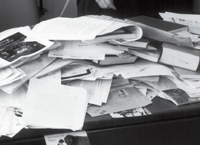 All
six, nominated for this story by their friends around the quads,
admit to taking at least an occasional stab at office reorganization.
The rest of the time the professors-a group whose honors include
one Nobel Prize, two MacArthur Foundation "genius" awards,
and two Quantrell awards for undergraduate teaching-negotiate
workspaces filled with piles, stacks, and boxes. And, in news
that should inspire messy readers everywhere, they get a lot done.
All
six, nominated for this story by their friends around the quads,
admit to taking at least an occasional stab at office reorganization.
The rest of the time the professors-a group whose honors include
one Nobel Prize, two MacArthur Foundation "genius" awards,
and two Quantrell awards for undergraduate teaching-negotiate
workspaces filled with piles, stacks, and boxes. And, in news
that should inspire messy readers everywhere, they get a lot done.
CHAOS
THEORIES - MICHAEL S. TURNER
LAW AND DISORDER - CASS R. SUNSTEIN
MESOZOIC MESS - JAMES HOPSON
COLLIDING INTERESTS - R. STEPHEN BERRY
SOUND SYSTEM - JOHN EATON
MASS PRODUCTION - ROBERT R. FOGEL
CHAOS
THEORIES - MICHAEL S. TURNER
No.
1 on Michael Turner's to-do list, despite the spring-cleaning
schedule optimistically chalked on his blackboard a few years
back, is "to figure out what's causing the universe to speed
up. So far," says Turner, the Bruce V. & Diana Rauner
distinguished service professor in astronomy & astrophysics,
physics, the Enrico Fermi Institute, and the College, "all
we've done is give it a name. We call it dark energy."
Turner
himself is credited with coining that phrase to describe the unknown
force that causes the accelerating expansion of the universe.
"Stars, us, earth, trees-we're made of star stuff,"
the theoretical astrophysicist says, "but we're not made
of the stuff of the cosmos": dark matter. "I'm hoping
to find dark matter on my desk," he continues, only half
joking.
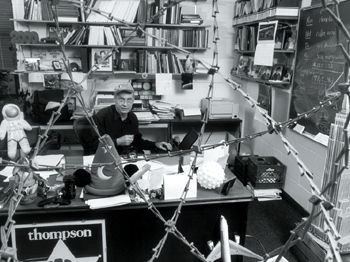
He's
well aware that the masses of star stuff in his office can have
almost magical properties. "One of the things that we all
try to do is avoid thinking linearly. Having a messy desk helps
do that," he theorizes. "It provides the odd connection.
It's constructive chaos. Two folders spill on top of one another,"
and a "goofy" connection is born. Serendipity also enters
the equation. "I'll have this idea on the back burner,"
he explains, "so I'll keep the folder on my desk. A student
or a post-doc comes in and says, 'I was thinking about this,'
and I say, 'So am I! Let's see what we've got.'"
Many
items in Turner's office have, at first glance, nothing to do
with his research or his duties as department chair, but he makes
the connections. There's a wizard hat, Mickey's ears still attached.
"I like to think of myself as a wizard. A wizard's hat helps
me get good ideas." There are "all my room keys from
my last year of travels-that remind me why I'm weary. I've got
a little action-hero figure here, so I can be tough. And I have
a glass paperweight that my grandmother gave me."
Also
on the desk is a "little harmless looking device," his
laptop computer. He laughs and confesses, "That's where the
real piles are."

LAW
AND DISORDER - CASS R. SUNSTEIN
Asked
what's on top of his desk midway through spring quarter, Cass
R. Sunstein, the Karl N. Llewellyn distinguished service professor
in the Law School, political science, and the College, provides
a quick if daunting list: "Materials for my course on environmental
law; materials for a book I'm co-authoring on jury decisions about
punitive damages; materials for a book I'm doing on regulating
risks; materials for a book that I may be co-editing on the legal
rights of animals."
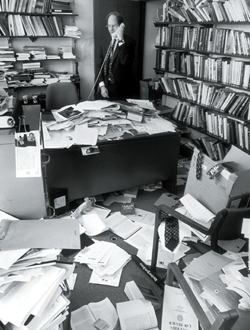 Sunstein's
most paper-intensive project is the book on regulating risks,
a topic he's been working
on for the past 15 years. "I have tons of materials on, for
example, global warming, motor- vehicle safety, hazards at work,
genetic engineering, acid rain, arsenic, and much more. A lot
of the mess involves these materials."
Sunstein's
most paper-intensive project is the book on regulating risks,
a topic he's been working
on for the past 15 years. "I have tons of materials on, for
example, global warming, motor- vehicle safety, hazards at work,
genetic engineering, acid rain, arsenic, and much more. A lot
of the mess involves these materials."
Despite
the "mess" and the lack of a system, Sunstein says,
"I do tend to know where things are." He qualifies:
"I know where everything important is, and I don't usually
lose things. But I have lost checks, made out to me, and I also
find coffee cups and Coke cans in surprising places." He
does reorganize on occasion: "When it gets completely disgraceful,
I improve it a bit. Usually I clean up a bit in the summer. Right
now it's gotten completely disgraceful, I guess."
Very
few items-ties and KitKat wrappers notwithstanding-in Sunstein's
office on the fourth floor of the Laird Bell Quadrangle are unrelated
to his work. The "most unusual" set of items in the
room, he says, "may be my CD collection, which features Inter
Alia, Bob Dylan, Sheryl Crow, Liz Phair, Bruce Springsteen, and
Shawn Colvin. Eminem can also be found here."
And
while his office may be disgraceful, his home, Sunstein declares,
"is actually very neat. No mess at all. I keep it that way,
partly for my 11-year-old daughter."

MESOZOIC
MESS - JAMES HOPSON
James
Hopson, PhD'65, professor in organismal biology & anatomy,
would like to be more organized: "I'd like to be able to
go to the right file or put my hand right on what I need without
having to search through a lot of stuff to find it." But
the vertebrate paleontologist admits that lots of stuff goes with
the territory.
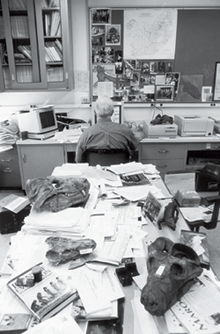 Hopson
studies the evolutionary transition from reptiles to mammals,
in particular he studies synapsids, or mammal-like reptiles, of
the Mesozoic age. In describing and classifying a new fossil,
he explains, the literature of the past cannot be ignored. "I
have a huge number of reprints and photocopies of the literature
in my field. In an historical science like paleontology, one must
refer to earlier papers describing relevant fossil specimens.
Good descriptions, and especially illustrations, don't go out
of date and can provide useful comparisons when studying new fossil
specimens."
Hopson
studies the evolutionary transition from reptiles to mammals,
in particular he studies synapsids, or mammal-like reptiles, of
the Mesozoic age. In describing and classifying a new fossil,
he explains, the literature of the past cannot be ignored. "I
have a huge number of reprints and photocopies of the literature
in my field. In an historical science like paleontology, one must
refer to earlier papers describing relevant fossil specimens.
Good descriptions, and especially illustrations, don't go out
of date and can provide useful comparisons when studying new fossil
specimens."
He
does have an organizational system, he says. "In general,
I have piles of papers and books on a given project in progress
on a particular counter-top or file-cabinet top or in particular
file boxes." And he confesses that his preferred method may
in fact be a revolt against his early upbringing: "Messy
surfaces were, and still are, anathema to my mother."
When
the surfaces get "so bad I can't find anything," he
reimposes order, "and for a while I can find reprints or
books on a given topic, or my desk is clean enough that there
is only one layer of papers covering it instead of three or four."
Along
with the reprints and the other papers-a grad student's dissertation,
manuscripts to review for professional journals, and several manuscripts
in progress-his surfaces host a number of synapsid crania brought
back from field studies in South Africa. There's also a bronze
sculpture of a Thrinaxodon liorhinus. His wife, Susan,
commissioned the South African cynodont from a scientist-artist
friend. "It's a fossil animal on whose bones and teeth I
have worked," Hopson says, "so I am very fond of it."

COLLIDING
INTERESTS - R. STEPHEN BERRY
When
Stephen Berry, the James Franck distinguished service professor
in chemistry, looks past the 18-inch mounds of papers heaped on
his desk, he sees works by well-known Chicago artists Cosmo Campoli,
Leon Golub, AB'42, and Richard Hunt, X'56.
Steve
Berry also sees the remnants of his own private "Berlin Wall,"
20 or so cardboard boxes left over from the office cleaning done
by his secretary, Mary Giacomoni, while he spent a year in Berlin
in 1994. "They had a pool to see what was the oldest handwritten
note she'd find," Berry says, "I think it dated to 1972
or '73."
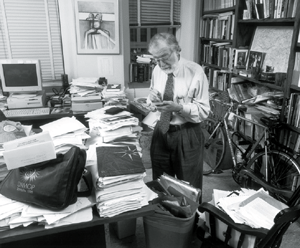
These
days he spends half of his time as home secretary of the National
Academy of Sciences. In that role, he chairs the National Research
Council's Report Review Committee, going over the hundred or so
policy studies the council produces each year. Most of those reports
arrive electronically: "I only download the ones that require
special scrutiny."
So
what's on his desk? "This is a paper I'm about to send out.
These are papers I've just gone through. This is a set of papers-whoops,
this is a paper I forgot to take home," he says, taking the
envelope and placing it in an already full briefcase. Berry-whose
research interests include atomic collisions, thermodynamics,
and the behavior of subnanoscale particles and their relation
to proteins, and, yes, chaos-doesn't know what's at the bottom
of every pile but he "definitely" has a system: "I
believe in pursuing a nonrigid, fluid approach, so that different
subjects have no sharp boundaries separating them, and each new
subject gets addressed with no preconceived organization."

SOUND
SYSTEM - JOHN EATON
Composer
and music professor John Eaton will pack up the contents of his
Goodspeed Hall office this June. After ten years on Chicago's
faculty, he's retiring and moving to New York-taking with him
two pianos, a keyboard "which was about a 30-year project
between Robert Moog and myself," and lots of computer stuff.
Plus the contents of his bookcase ("papers, scores, lots
of things I haven't done") and a water dish and old rug that
belong to his frequent office mate, a 7-year-old Great Dane named
Cassandra.
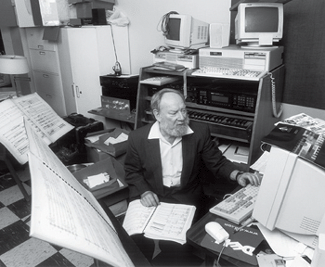
The
packing should take about a week: "There is a lot of stuff
that I'll throw away, but there's a lot of stuff that's invaluable-like
scores, parts of pieces, unfinished compositions-stuff that's
absolutely irreplaceable. It has to be not only packed, but very
carefully filed before I go."
In
general, Eaton says, "I keep things kind of in the right
place," with separate places for materials related to his
composing, to his teaching, and to the Pocket Opera Company of
Chicago, a group he founded in 1992 to bring new music and operas
to people throughout the city.
"Every
time I start to clean up," to replace the files that have
somehow gotten out of place, "I get an idea for a new piece.
All things being equal, I'd rather not work in a pigsty, but I
never have the time to just clean up."
Why
two pianos? "The reason for that is that I write music
using microtones, intervals besides the white and black keys."
The pianos, tuned a quarter of a note apart, "get used constantly
for coaching other performers in the singing of my music."
One
thing you won't find in this office or in his new one, Eaton says,
are copies of most of his own recordings. "I don't like to
keep them around. I don't like to have to keep listening to them,
looking back."

MASS
PRODUCTION - ROBERT R. FOGEL
Robert
Fogel had too many projects for one desk. So the Charles R. Walgreen
distinguished service professor of American institutions in the
Graduate School of Business did what any good Chicago economist
would do and matched supply to demand. "I have a desk behind
me and a desk in front of me," he says. "The desk behind
me vies with the desk in front of me for the highest piles."
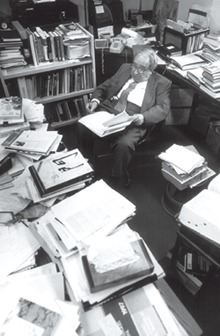 On
his desktops are manuscripts for a series of three lectures, "The
Slavery Debates, 1952-1990: A Memoir." Fogel (whose Time
on the Cross: The Economics of American Negro Slavery pioneered
statistical methods to analyze how the slave system in America
operated, upsetting conventional wisdom) has just given the lectures
at Louisiana State University and is preparing them for publication
by the LSU Press.
On
his desktops are manuscripts for a series of three lectures, "The
Slavery Debates, 1952-1990: A Memoir." Fogel (whose Time
on the Cross: The Economics of American Negro Slavery pioneered
statistical methods to analyze how the slave system in America
operated, upsetting conventional wisdom) has just given the lectures
at Louisiana State University and is preparing them for publication
by the LSU Press.
On
an adjacent pile are "the latest printouts on measurements
that I'm making together with one of my graduate research assistants
on what has happened to the age of onset of chronic diseases during
the course of the 20th century." Do people turning 65 today
experience more years free of disease- or chronic conditions than
did their turn-of-the-19th-century counterparts? What's the duration
of chronic conditions, and how severe are they? The answers, Fogel
says, offer "important implications for forecasting what's
going to happen in health-care costs during the next half century."
Other
stacks of literature and printouts concern issues of productive
efficiency. "In 1800 it took five people working on the farm
to provide food for one person off the farm-80 percent of the
labor force was in agriculture. Today only 2 percent of the labor
force feed 100 people off the farm-half of our agriculture output
gets exported. Will that continue?"
Consumed
by such questions, Fogel admits that he reorganizes his office
"only when I move," which he last did in 1981. And although
he has a "very good" idea of where his research is,
he says that when it comes to other papers, "My secretary
is instructed to never give me the original of anything. I'm a
great disposer of documents."


![]()
 All
six, nominated for this story by their friends around the quads,
admit to taking at least an occasional stab at office reorganization.
The rest of the time the professors-a group whose honors include
one Nobel Prize, two MacArthur Foundation "genius" awards,
and two Quantrell awards for undergraduate teaching-negotiate
workspaces filled with piles, stacks, and boxes. And, in news
that should inspire messy readers everywhere, they get a lot done.
All
six, nominated for this story by their friends around the quads,
admit to taking at least an occasional stab at office reorganization.
The rest of the time the professors-a group whose honors include
one Nobel Prize, two MacArthur Foundation "genius" awards,
and two Quantrell awards for undergraduate teaching-negotiate
workspaces filled with piles, stacks, and boxes. And, in news
that should inspire messy readers everywhere, they get a lot done.
 Sunstein's
most paper-intensive project is the book on regulating risks,
a topic he's been working
on for the past 15 years. "I have tons of materials on, for
example, global warming, motor- vehicle safety, hazards at work,
genetic engineering, acid rain, arsenic, and much more. A lot
of the mess involves these materials."
Sunstein's
most paper-intensive project is the book on regulating risks,
a topic he's been working
on for the past 15 years. "I have tons of materials on, for
example, global warming, motor- vehicle safety, hazards at work,
genetic engineering, acid rain, arsenic, and much more. A lot
of the mess involves these materials."  Hopson
studies the evolutionary transition from reptiles to mammals,
in particular he studies synapsids, or mammal-like reptiles, of
the Mesozoic age. In describing and classifying a new fossil,
he explains, the literature of the past cannot be ignored. "I
have a huge number of reprints and photocopies of the literature
in my field. In an historical science like paleontology, one must
refer to earlier papers describing relevant fossil specimens.
Good descriptions, and especially illustrations, don't go out
of date and can provide useful comparisons when studying new fossil
specimens."
Hopson
studies the evolutionary transition from reptiles to mammals,
in particular he studies synapsids, or mammal-like reptiles, of
the Mesozoic age. In describing and classifying a new fossil,
he explains, the literature of the past cannot be ignored. "I
have a huge number of reprints and photocopies of the literature
in my field. In an historical science like paleontology, one must
refer to earlier papers describing relevant fossil specimens.
Good descriptions, and especially illustrations, don't go out
of date and can provide useful comparisons when studying new fossil
specimens."

 On
his desktops are manuscripts for a series of three lectures, "The
Slavery Debates, 1952-1990: A Memoir." Fogel (whose Time
on the Cross: The Economics of American Negro Slavery pioneered
statistical methods to analyze how the slave system in America
operated, upsetting conventional wisdom) has just given the lectures
at Louisiana State University and is preparing them for publication
by the LSU Press.
On
his desktops are manuscripts for a series of three lectures, "The
Slavery Debates, 1952-1990: A Memoir." Fogel (whose Time
on the Cross: The Economics of American Negro Slavery pioneered
statistical methods to analyze how the slave system in America
operated, upsetting conventional wisdom) has just given the lectures
at Louisiana State University and is preparing them for publication
by the LSU Press.